| Please access the following URL if you want to secure using SSL. All pages in the site will be secure pages. |
| https://secure02.blue.shared-server.net/www.fish-food.co.jp/message english 9.2020.html |
Welcome to FISH FOOD TIMES
Sep. 2020 issue No.201


Longfinned bullseye fried skin with scales
One of the autumn fish
When the hot August ends and September ends, the seasonal saury should buzz the fish counter every year. However, in the case of this year, the poor catch of saury, which has been going on for years, is likely to become a poor catch compared to last year.
This year's peak season for saury is likely to be around October in the case of off Sanriku, so to speak, it is "around the peak in autumn." Thinking that business is to stay ahead of the season, it seems that we may miss the time.
It is said that one of the causes of saury poor catch is that China, Taiwan, South Korea, etc., catch a large amount of saury on the open sea of the Pacific Ocean before the saury migrates to the waters near Japan. On the other hand, saury is competing for the same feeding ground as sardine, which has been gaining momentum in recent years, and saury is losing its momentum.
As in recent years, the trend of “sardines are cheap and saury is expensive” cannot be avoided this fall. It seems difficult to mass sell saury as a fish that appeals to the autumn season, so another fish must be picked up as the seasonal fish at the fish section.
For example, what about the Longfinned bullseye in the image below?
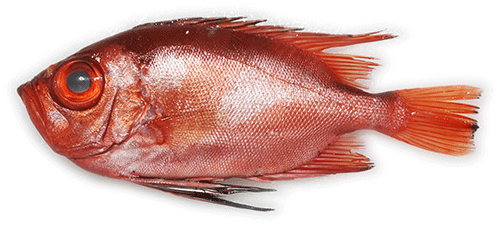
It may be said that I haven't heard much about autumn fish, but the longfinned bullseye is one of the fish that is in season from autumn. Although it is not a mass-fished species like saury and sardine, Longfinned bullseye's deliciousness is very good.
Fish of a different species from splendid alfonsino
The fish called Longfinned bullseye has a large fisheye like splendid alfonsino, and is sometimes sold under the name "Kimme", depending on the location and store. However, Longfinned bullseye belongs to Order:Perciformes, Family:Priacanthidae, Genus:Priacanthus. It is a different kind of fish from Order:Beryciformes, Family:Berycidae, Genus:Beryx splendid alfonsino, which has a large eyeball that resembles a red fish.
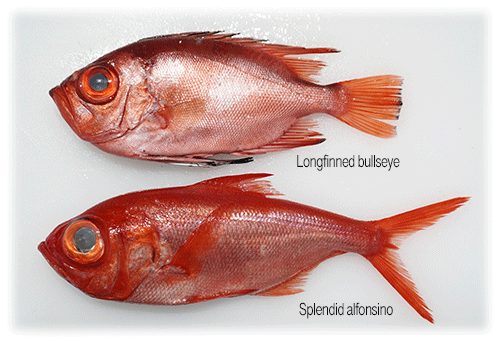
Also, the same image as the red bigeye of Genus:Priacanthus, which is the same as the Longfinned bullseye, is shown below. It is lower in body length and longer than the family's Longfinned bullseye. The fact that the distance between the rim of the mouth and the eyeball, which is the origin of the name of Longfinned bullseye, is narrow and close, the Red bigeye is farther from the mouth than the Longfinned bullseye.
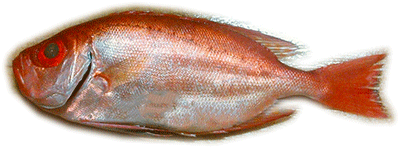
Another characteristic of the two fish species, Longfinned bullseye and Red bigeye, is that the fish surface is small and covered with hard scales, which are so sticky that they are difficult to remove easily. The thick and hard skin is another characteristic of these two fish species. On the other hand, the scales of splendid alfonsino are not so small and their skin is soft, so they can be eaten deliciously by roasted frost or hot water, which is also a big difference between Genus:Priacanthus 2 fish species and splendid alfonsino. About splendid alfonsino, I wrote an article in FISH FOOD TIMES October 2010 No.82 "splendid alfonsino seared sashimi", so please take a look.
Make good use of small hard scales and thick skin
The long finned bullseye's main characteristics are its small, hard scales and thick skin. The presence of Longfinned bullseye will be greatly different depending on whether you cut these as extra obstacles and throw them away, or if you manage to make them delicious dishes.
The most famous and delicious fish that you can eat with scales is the horsehead tilefish, which is called guji in the Kyoto region. This fish is well known to the general public, so let's go through this time, and as a fish picked up in the past at FISH FOOD TIIMES, we cannot avoid the damselfish.

In the June 2017 issue No.162 of FISH FOOD TIIMES, the damselfish whole salt-grilled dish in the above image was described as follows.
This whole way of how to eat the grilled salt is just biting from the head, putting it in the mouth, and eating bones and internal organs as it is. For that reason, the size is as easy to eat as possible with the smallest possible, and those who are good in that way choose to purchase a relatively small size and purchase. Unfortunately I am not good at that way, so I do a luxurious way of eating that I do not eat any head, bones or internal organs.Damselfish from May to July has visceral fat swelling up to the abdominal cavity, and if you do eat which is not expert like the writer, you have to be prepared to realize that the actual edible portion is very few. |
And,I wrote at that time as follows.The most popular was the deep-fried with this scalp. Despite having a small bone, it was not as bothersome as it was, but the texture of the scales felt fancy and the surface was crispy and it was able to taste the moist and fried fish's mouthfeel while it was crisp.
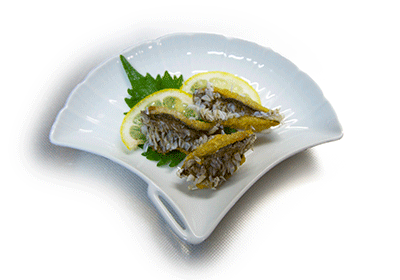
Having had this kind of experience in the past, Longfinned bullseye decided to try cooking with similar scales.�B
| Deep-fried longfinned bullseye with scales |
 |
| 1�CWithout dropping the scales, make three pieces disassembling. |
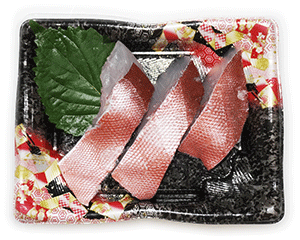 |
| 2�CIntentionally, make the fillet with the scale. |
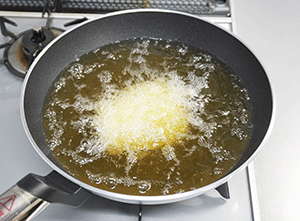 |
| 3�CFlour the fillet with the scales and fry in oil at a high temperature of 180 degrees. |
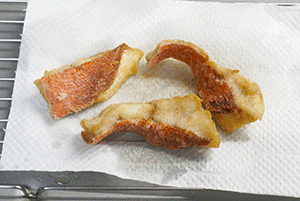 |
| 4�CDeep fried until the surface becomes crispy. |
 |
| Deep-fried longfinned bullseye with scales completed |
The long finned bullseye deep-fried with scales had a texture almost similar to damselfish fried food, the hardness of the scales was felt slightly, and the surface had a crunchy texture.
Next is a deep fried dish using Longfinned bullseye skin.
| Longfinned bullseye fried dish with scales on the skin | |
 |
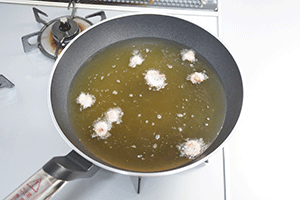 |
| 1�CRemove skin of Longfinned bullseye with scales. | 4�CFry in oil at a high temperature of 180 degrees. |
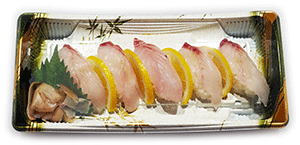 |
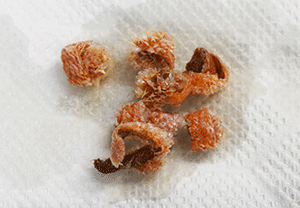 |
| 2�CFish meat is used to cook sushi and sashimi. The longfinned bullseye's raw taste has a lot of umami and is of a first-class taste. | 5�CAfter frying, , then for a while oil cut. |
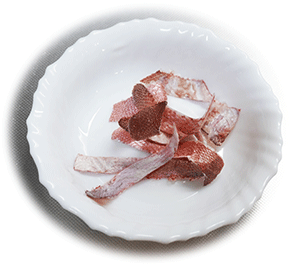 |
 |
| 3�CCut the skin with scales into 1 to 2 cm width without making it too thin. | 6�CA small scale standing on the surface of the skin like a white crystal. |
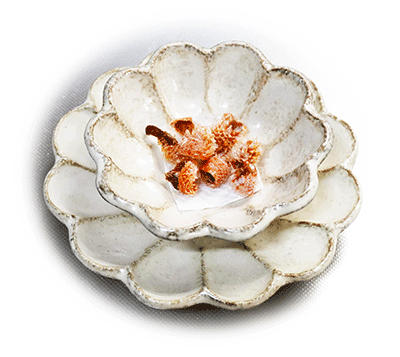 |
|
| Longfinned bullseye fried dish with scales on the skin completed. Season with salt and pepper if you like. | |
The scales of Longfinned bullseye are small and difficult to remove, and the skin is thick, making it difficult to make hot water frost sashimi or seared sashimi products. That is a troublesome disadvantage in the ordinary way of thinking. However, by changing the way of thinking how to eat scales and thick skin deliciously, such a dish can be made.
Make good use of fish skin
√This month's issue intentionally made the fish skin the protagonist. Not because the body of the long finned bullseye of the material is not delicious, it is a fish that has the best taste of the best class, but I introduced it as an example to make good use of other parts.
When cooking sashimi and sushi, fish skins are basically thrown away, and even if they are grilled fish dishes, they are often left uneaten at the end, and the skins are treated as an obstacle if they are not used consciously. It is not uncommon to see piles of fish skin abandoned during cooking on a residue box in a fisheries workshop.
However, there is a fat layer between the fish skin and the fish meat, which contains much of the taste, so discarding the skin also discards the delicious portion of the fish. In the past, in the FISH FOOD TIMES February 2015 issue No.134, the author introduced product proposals that make the most of the skin using red sea bream. At that time, the price of red sea bream had fallen sharply, so I remember writing an article to strongly encourage the sale of red sea bream, but at this point in time again, the market price of red sea bream has likewise been sluggish. In the future, for the promotion of red sea bream, and this is also the basic content of the method of utilizing fish skin, so I will excerpt a part of it below.
| Partial excerpt from the article in FISH FOOD TIMES February 2015 No.134 |
Flavor components of the fish there are many in the portion of the fat layer between the fish skin and the fish meat. Method of Yushimo (hot water frost) that will eat confine all of these is a method that can be eaten more delicious than ordinary nigiri sushi having removed the fish skin. Of course, this is delicious also of that Yushimo (hot water frost) of sashimi as well as nigiri sushi.
Above image is an example of the aquaculture red sea bream of 1.2�s size, 1 pack 680 yen in the dorsal of the portion, and I tried to commercialization in the selling price of one pack 380 yen in the abdominal only. This would be innocuous lines as Yushimo (hot water frost) sashimi products to make an ordinary red sea bream. However, now that the purchase price is suppressed cheap, and not in such a volume, the commercialization of in half the body, such as in the following image using a similar size, reasonably attractive selling price that around 680 yen to 780 yen presentation can be.
Also, instead of making yushimo (hot water frost), after making sashimi and nigiri sushi with peeled skin, the remaining skin can be made into the following products.
The tanzaku before sashimi should be commercialized as a yushimo (hot water frost) tanzaku by separating the back body and belly body as shown in the image below.
First, put the skin in hot water, and the cooled it with ice water, take the last lightly moisture.
Rounded the skin that was in the yushimo vertically, and chop thin this.
This as two of the image above, they may be served with in the sashimi as "ahirai",
As the image, the dressing sachet is added in salad sense, it would be provided as the sole product. |
Recently, not only yushimo but also seared fish called "aburi" seems to be popular in sushi, but this is also one of the ways to utilize the deliciousness of the skin.
The image below is a seared figure sashimi of blackthroat seaperch, also called nodoguro, and one of the fishes that can fully utilize the deliciousness of aburi.

Taking aburi as an example of sushi, the Argentine red shrimp in the image below is also one of the products that enhances the taste of aburi.
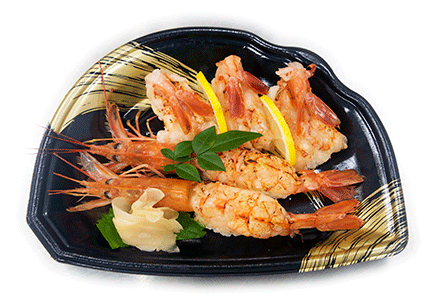
Of course, not only expensive fish is delicious
Last month's August issue of FISH FOOD TIMES was white trevally, a representative of high-end fish traded at high transaction prices. And in September of the usual year, saury, which should be traded at a cheap popular price, is currently a high-class fish with a selling price of 1,000 yen or more per fish. Looking at it in this way, the price of expensive fish at that time varies greatly depending on the landing and resource situation, the relationship between supply and demand, and the target fish species also changes depending on the time and environment.
The main character of this time, the Longfinned bullseye, is a little less than 500g, and the purchase price is about 300 yen per fish, so it was not high. It seems that the price of Longfinned bullseye tends to be higher for larger fish and cheaper for smaller fish. In that sense, it seems that the size and price were reasonable.
Today's fish market products include farmed fish and frozen fish to hold sway, and the presence of natural fish is extremely weak. Trading companies and wholesalers sell stable farmed fish and frozen fish, and the purchase price tends to be stable at high prices. If these cultured fish and frozen fish are used as materials for products, planned sales can be made on the premise of efficient and rational work, but a high markup ratio cannot always be secured. This is also the operational difficulty of the fisheries sector.
It would be unsatisfactory for the fish department to pursue only efficiency and rationality, and what would happen if we pursued only standardized commercialization in line with the manual, seeking further labor savings? The answer is clear when you look at some examples nationwide in which only the fisheries department has been forced into a slump in sales, called the lose one person, in the supermarket.
The content of the product is taken a back seat, and the priority is to hurry to make a standard product in time, and if there is no room for wisdom and ingenuity, there is no need to put fish-loving customers back as repeat customers. It is not possible to continue to draw to the fish counter.
When autumn comes, it's appropriate to think that the old successful sales method, such as "selling a saury for 100 yen per volume," will not be possible for the time being, or may not be possible at all. The method of selling fish should be reviewed from various aspects, and I would like to see the skin of fish as one of the hints.
Although it is only "fish skin", the evaluation of the fish store must be greatly different depending on how the fish skin is used.
| Please access the following URL if you want to secure using SSL. All pages in the site will be secure pages. |
| https://secure02.blue.shared-server.net/www.fish-food.co.jp/message english 9.2020.html |
An opinion and the communication are to iinfo@fish food times
Date of updating 1 Sep. 2020

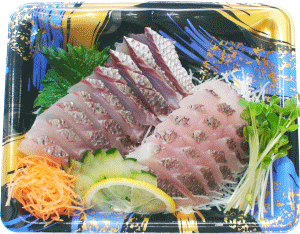 �@�@�@
�@�@�@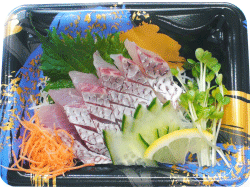





 �@�@�@
�@�@�@
